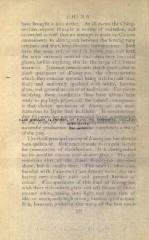Page 432 - Oriental Series Japan and China, Brinkly
P. 432
have brought it into notice. At all events the Ching-
te-chen experts thought it worthy of imitation, and
succeeded so well that no attempt is made by Chinese
connoisseurs to distinguish between the Kwang-tung
originals and the Ching-te-chen reproductions. Both
have the same red, or reddish brown pafe, and both
the same curiously mottled and often very beautiful
glazes, unlike anything else in the range of Chinese
keramics. Japanese connoisseurs attach great value to
good specimens of Kwang-yao, the characteristics
which they consider essential being rich but soft blue,
finely and uniformly speckled "with white, lustrous
glaze, and general accuracy of technique. For pieces
satisfying these conditions they have always been
ready to pay high prices, and the natural consequence
mis that choice specimens of Kwang-yao are
'
numerous in Japan than in China. It seems strange
that this ware has not commanded
VASE (HEIGHT, 14 INCHES) OF KANG-HSI, EGGSHELL TING-YAO ;
West, tor its OFT PA STE.
successful production webee 263.) ictely a thing
of the past.
The third principal variety of Kwang-yao has already
been spoken of. Reference is made to it again merely
for convenience of classification. It is distinguished
by its peculiar viscous clair-de-lune glaze. The pate
resembles that of the flambe Kwang-yao described
above, but is usually finer. This ware is often con-
founded with Tuan-tsu (Yuan dynasty ware), the two
having very similar pates and general likeness of
Kcolour. Fine specimens of this kind of
ao,
with their rich velvety glaze and soft bloom iish
creamy white, passing into light and deep tints of
lilac or azure, rank high among keramic productions.
It is, however, probable that many of the best speci-

